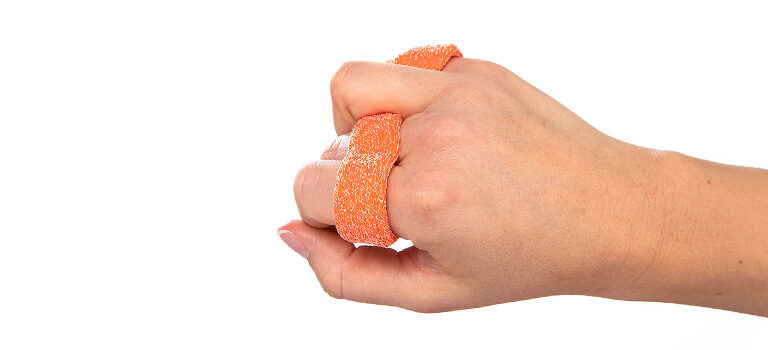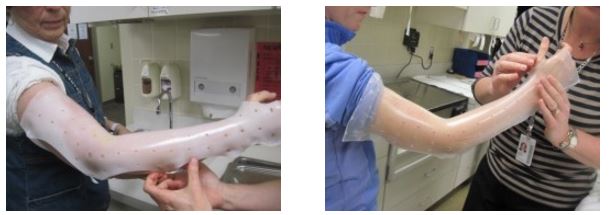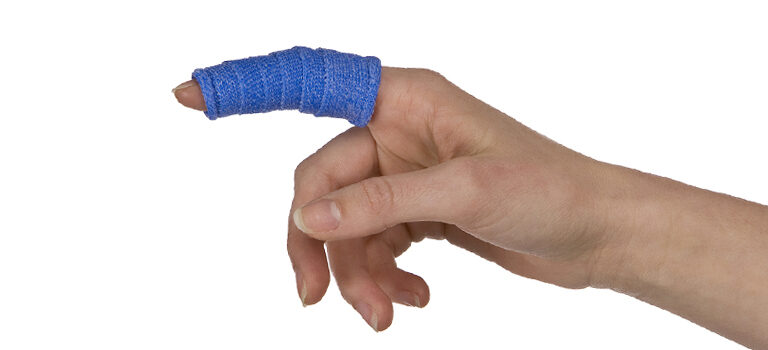
Splint in the Spotlight: Circumferential Elbow Splint for Elbow Positioning

Our Orfit blog shares information and instructions in matching our thermoplastic materials to orthotic designs.
Please check back frequently to gain inspiration and ideas in orthotic fabrication for all of your patient’s needs.
Today, we focus on the Circumferential Elbow Splint for Elbow Positioning.
Pathology:
Patients with a variety of pathologies or trauma affecting the elbow joint, forearm bones, upper arm musculature and peripheral nerves often need to have their elbow immobilized during the healing process. Elbow splints can be positioned anteriorly on the arm or posteriorly behind the arm. Often, posterior elbow splints are used after trauma or surgery to protect and rest the elbow joint and surrounding soft tissues. They may also be used to restrict forearm motion. Anterior elbow splints are commonly fabricated for patients with cubital tunnel syndrome, also known as ulnar nerve entrapment. This condition occurs when the ulnar nerve in the arm becomes compressed or irritated at the elbow. Symptoms of cubital nerve compression include pain and paresthesia that run from the elbow to the fingers, typically the ulnar digits. Anterior elbow splints may also be utilized to statically position the contracted elbow at maximum extension and facilitate lengthening of tight soft tissues.
- Goals of orthotic fabrication include:
- Protection of healing structures;
- Symptomatic and/ or pain relief;
- Prevention of further ulnar nerve compression;
- Restriction of motion;
- Elongation of contracted tissues.
- In practice, the patient may benefit from:
- Night splinting to prevent compression of the ulnar nerve during elbow flexion;
- Night splinting for elongation of tight contracted soft tissues;
- Day time splint as needed for protection and relief of symptoms and pain.
Patient education is paramount to instruct patients on the proper wearing schedules that offer them the greatest benefit.
*Careful consideration should be given to the splint strapping. The strapping must not cause pressure areas or decrease the patient’s level of functioning. Patients should be able to put on and take off their splints unaided.
Splint solution:
Orfit NS (3.2mm or 1/8”, mini perfo) or Aquafit NS (Stiff, 3.2mm or 1/8”, macro perfo) are both excellent low temperature thermoplastic materials for fabrication of anterior and posterior elbow orthoses.
These materials are elastic and conforming. The coating allows the orthosis to be made circumferentially, with corners pinched together for holding and then opened when the material has cooled. This ensures a well conforming and fitting orthosis. Both of these products have excellent memory allowing the orthosis to be easily adjusted if the elbow position needs to be altered.
To fabricate this orthosis, place the patient’s arm in the desired position of elbow flexion and forearm rotation. Simply cut a rectangle of the Orfit NS or Aquafit NS thermoplastic materials and activate in hot water, 140-160°F (65°C). When heated sufficiently, dry the material on a towel, and place the proximal edge of the material over the patient’s upper arm. Pinch the corners together behind the arm to lock in place. Stretch the distal border of the material to the wrist level (or include the wrist for extra leverage and pinch at the MCP joint level, leaving an opening for the thumb). Pinch on the posterior side of the arm to hold the material in place, leaving the material taut over the flexed elbow. The last step is to take the material at the elbow level and pinch around behind the flexed elbow. This stretching of the material allows it to conform accurately to the patient’s anatomy.
When cooled, the material can be opened at each of the pinched areas, and the pinched areas can be trimmed away. Strapping is provided proximally and distally as needed to secure the splint to the arm.

The same technique can be used in fabricating a posterior fitting splint of the elbow as well.
This method is particularly helpful when the patient is not able to hold their elbow over their head in a gravity eliminated posture. The patient can be sitting or standing with the elbow held in flexion and the forearm in the desired degree of rotation. The therapist can easily maneuver the heated thermoplastic material around the arm.

The circumferential elbow splint described here helps to position the elbow and forearm and restricts full elbow flexion.
You can find an instruction video for the Gauntlet thumb post splint here.
This splint can be fabricated for the treatment of:
- Pre- and post-operative management of elbow and forearm fractures
- Severe cases of lateral and medial epicondylosis
- Post-operative management of cubital tunnel syndrome or other nerve injuries
- Elbow arthritis or bursitis
Questions?
If you have a question or comment, please post it in the Orfit Splinting & Rehabilitation Group on Facebook, or send an email to welcome@orfit.com.



